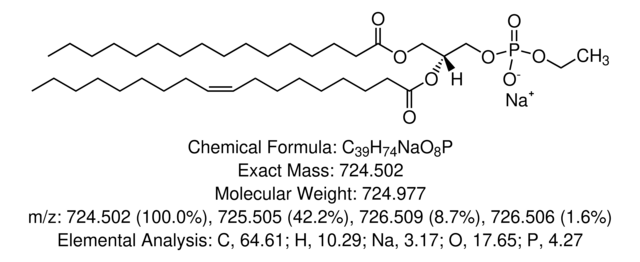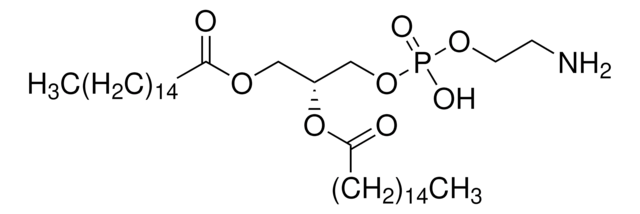850699C
Avanti
08:0 PE
1,2-dioctanoyl-sn-glycero-3-phosphoethanolamine, chloroform
Sinonimo/i:
PE(8:0/8:0)
About This Item
Prodotti consigliati
Saggio
>99% (TLC)
Forma fisica
liquid
Confezionamento
pkg of 1 × 1 mL (850699C-10mg)
pkg of 1 × 2.5 mL (850699C-25mg)
pkg of 1 × 20 mL (850699C-500mg)
Produttore/marchio commerciale
Avanti Research™ - A Croda Brand 850699C
Concentrazione
10 mg/mL (850699C-10mg)
10 mg/mL (850699C-25mg)
25 mg/mL (850699C-500mg)
Condizioni di spedizione
dry ice
Temperatura di conservazione
−20°C
Stringa SMILE
[H][C@@](COP([O-])(OCC[NH3+])=O)(OC(CCCCCCC)=O)COC(CCCCCCC)=O
Descrizione generale
Applicazioni
Azioni biochim/fisiol
Confezionamento
Note legali
Avvertenze
Danger
Indicazioni di pericolo
Classi di pericolo
Acute Tox. 3 Inhalation - Acute Tox. 4 Oral - Carc. 2 - Eye Irrit. 2 - Repr. 2 - Skin Irrit. 2 - STOT RE 1 Oral - STOT SE 3
Organi bersaglio
Liver,Kidney, Respiratory system
Codice della classe di stoccaggio
6.1D - Non-combustible acute toxic Cat.3 / toxic hazardous materials or hazardous materials causing chronic effects
Classe di pericolosità dell'acqua (WGK)
WGK 3
Punto d’infiammabilità (°F)
does not flash
Punto d’infiammabilità (°C)
does not flash
Certificati d'analisi (COA)
Cerca il Certificati d'analisi (COA) digitando il numero di lotto/batch corrispondente. I numeri di lotto o di batch sono stampati sull'etichetta dei prodotti dopo la parola ‘Lotto’ o ‘Batch’.
Possiedi già questo prodotto?
I documenti relativi ai prodotti acquistati recentemente sono disponibili nell’Archivio dei documenti.
Il team dei nostri ricercatori vanta grande esperienza in tutte le aree della ricerca quali Life Science, scienza dei materiali, sintesi chimica, cromatografia, discipline analitiche, ecc..
Contatta l'Assistenza Tecnica.










